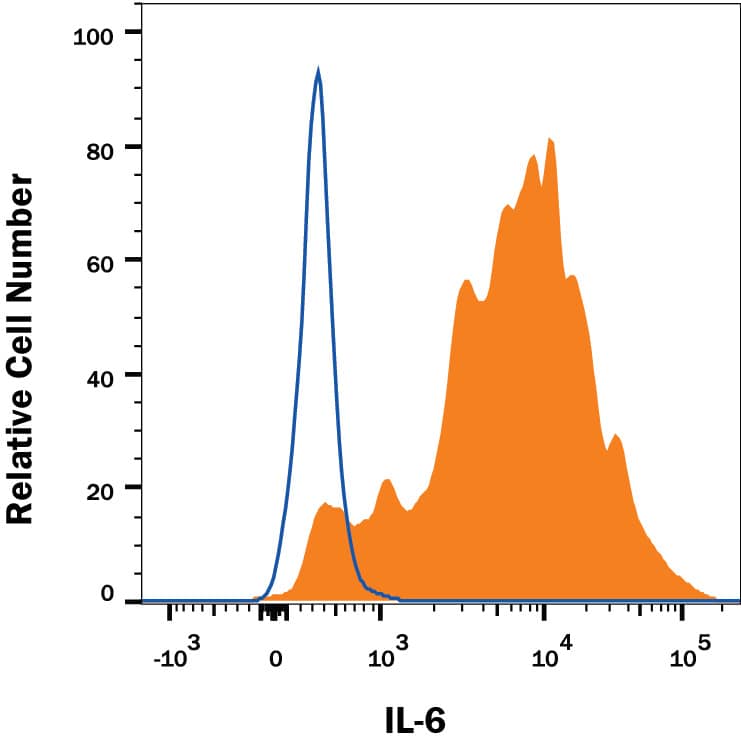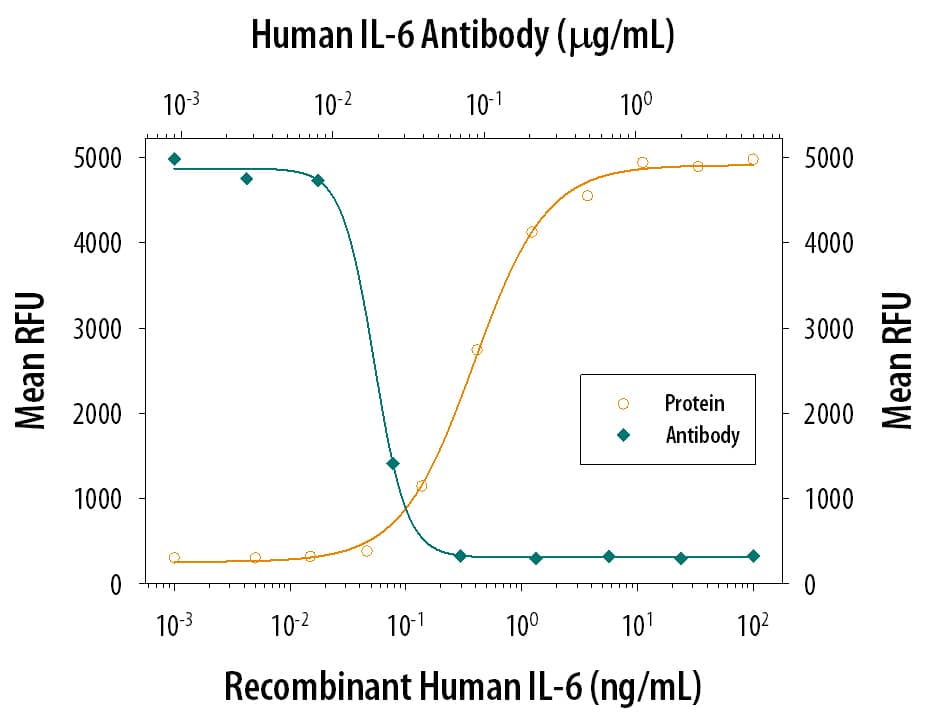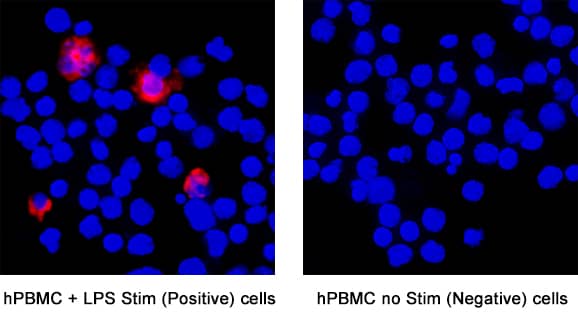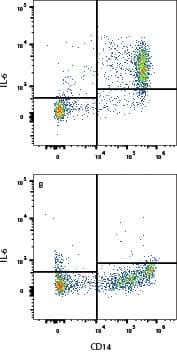Human IL-6 Antibody
R&D Systems, part of Bio-Techne | Catalog # MAB2061

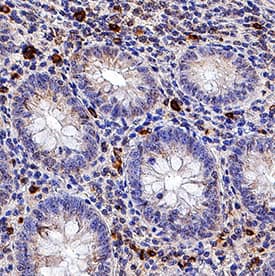
Conjugate
Catalog #
Key Product Details
Validated by
Biological Validation
Species Reactivity
Validated:
Human
Cited:
Human, Mouse, Rat
Applications
Validated:
CyTOF-ready, Immunocytochemistry, Immunohistochemistry, Intracellular Staining by Flow Cytometry, Neutralization
Cited:
Bioassay, Cell Culture, Flow Cytometry, Immunocytochemistry, Immunohistochemistry, Immunohistochemistry-Paraffin, Neutralization, Western Blot
Label
Unconjugated
Antibody Source
Monoclonal Mouse IgG2B Clone # 1936
Product Specifications
Immunogen
E. coli-derived recombinant human IL-6
Val30-Met212
Accession # P05231
Val30-Met212
Accession # P05231
Specificity
Detects human IL-6 in direct ELISAs. Does not cross-react with recombinant IL-6 from mouse, rat, or pig.
Clonality
Monoclonal
Host
Mouse
Isotype
IgG2B
Endotoxin Level
<0.20 EU per 1 μg of the antibody by the LAL method.
Scientific Data Images for Human IL-6 Antibody
IL‑6 in Human Appendix.
IL-6 was detected in immersion fixed paraffin-embedded sections of human appendix using Mouse Anti-Human IL-6 Monoclonal Antibody (Catalog # MAB2061) at 1.7 µg/mL for 1 hour at room temperature followed by incubation with the Anti-Mouse IgG VisUCyte™ HRP Polymer Antibody (VC001). Before incubation with the primary antibody, tissue was subjected to heat-induced epitope retrieval using Antigen Retrieval Reagent-Basic (CTS013). Tissue was stained using DAB (brown) and counterstained with hematoxylin (blue). Specific staining was localized to cytoplasm in lymphocytes. View our protocol for IHC Staining with VisUCyte HRP Polymer Detection Reagents.Detection of IL‑6 in Human PBMCs by Flow Cytometry.
Human peripheral blood mononuclear cells (PBMCs) treated with 100 ng/mL LPS for 24 hours were stained with Mouse Anti-Human IL-6 Monoclonal Antibody (Catalog # MAB2061, filled histogram) or isotype control antibody (MAB004, open histogram), followed by Phycoerythrin-conjugated Anti-Mouse IgG Secondary Antibody (F0102B). To facilitate intracellular staining, cells were fixed with Flow Cytometry Fixation Buffer (FC004) and permeabilized with Flow Cytometry Permeabilization/Wash Buffer I (FC005). View our protocol for Staining Intracellular Molecules.Cell Proliferation Induced by IL‑6 and Neutralization by Human IL‑6 Antibody.
Recombinant Human IL-6 (206-IL) stimulates proliferation in the T1165.85.2.1 mouse plasmacytoma cell line in a dose-dependent manner (orange line). Proliferation elicited by Recombinant Human IL-6 (2.5 ng/mL) is neutralized (green line) by increasing concentrations of Mouse Anti-Human IL-6 Monoclonal Antibody (Catalog # MAB2061). The ND50 is typically 8.00-80.0 ng/mL.Applications for Human IL-6 Antibody
Application
Recommended Usage
CyTOF-ready
Ready to be labeled using established conjugation methods. No BSA or other carrier proteins that could interfere with conjugation.
Immunocytochemistry
3-15 µg/mL
Sample: Immersion fixed Human PBMCs stimulated with LPS (positive control) and untreated human PBMCs (negative control)
Sample: Immersion fixed Human PBMCs stimulated with LPS (positive control) and untreated human PBMCs (negative control)
Immunohistochemistry
1-25 µg/mL
Sample: Immersion fixed paraffin-embedded sections of human appendix
Sample: Immersion fixed paraffin-embedded sections of human appendix
Intracellular Staining by Flow Cytometry
0.25 µg/106 cells
Sample: PBMCs treated +/- LPS (see details below)
Sample: PBMCs treated +/- LPS (see details below)
Neutralization
Measured by its ability to neutralize IL‑6-induced proliferation in the T1165.85.2.1 mouse plasmacytoma cell line. The Neutralization Dose (ND50) is typically 8.00-80.0 ng/mL in the presence of 2.5 ng/mL Recombinant Human IL‑6.
Reviewed Applications
Read 2 reviews rated 4.5 using MAB2061 in the following applications:
Formulation, Preparation, and Storage
Purification
Protein A or G purified from hybridoma culture supernatant
Reconstitution
Reconstitute at 0.5 mg/mL in sterile PBS. For liquid material, refer to CoA for concentration.
Formulation
Lyophilized from a 0.2 μm filtered solution in PBS and NaCl with Trehalose. See Certificate of Analysis for details.
*Small pack size (-SP) is supplied either lyophilized or as a 0.2 µm filtered solution in PBS.
*Small pack size (-SP) is supplied either lyophilized or as a 0.2 µm filtered solution in PBS.
Shipping
Lyophilized product is shipped at ambient temperature. Liquid small pack size (-SP) is shipped with polar packs. Upon receipt, store immediately at the temperature recommended below.
Stability & Storage
Use a manual defrost freezer and avoid repeated freeze-thaw cycles.
- 12 months from date of receipt, -20 to -70 °C as supplied.
- 1 month, 2 to 8 °C under sterile conditions after reconstitution.
- 6 months, -20 to -70 °C under sterile conditions after reconstitution.
Background: IL-6
Long Name
Interleukin 6
Alternate Names
BSF-2, BSF2, IFNB2, IL6, MGI-2A
Entrez Gene IDs
Gene Symbol
IL6
UniProt
Additional IL-6 Products
Product Documents for Human IL-6 Antibody
Product Specific Notices for Human IL-6 Antibody
For research use only
